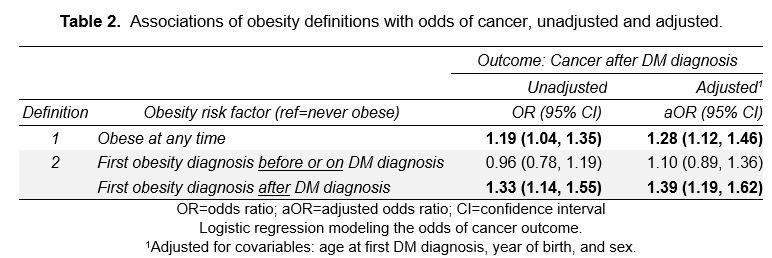Session Information
Session Type: Poster Session A
Session Time: 1:00PM-3:00PM
Background/Purpose: Dermatomyositis (DM) is an idiopathic inflammatory myopathy with an increased risk of mortality and morbidity from cancer. Across the general population, excess body weight is associated with both a greater cancer risk at thirteen different anatomic sites, including the esophagus, colon, liver, ovary and breast, and a higher relative risk of death from cancer. Although potential risk factors (TIF1-gamma antibody, older age) for cancer development in myositis patients have been studied, the potential effect of obesity on cancer development in myositis has not been evaluated. We aimed to investigate the association of obesity on malignancy prevalence in patients with DM.
Methods: This retrospective analysis used raw data extracted from TriNetX, a national federated research network of de-identified data from insurance registries. Patients were identified by entry of two International Classification of Disease (ICD) codes indicating DM separated by at least 6 months. Patients with a cancer ICD code that preceded the DM code were excluded. Cancers were identified by ICD coding, with secondary malignancies and non-melanoma skin cancer excluded. Obesity was identified by two ICD codes separated by 3 months. Logistic regression modeling the odds of cancer outcome was performed for patients with DM who were obese compared to those who were not obese, adjusted for covariables: age at first DM diagnosis, year of birth, and sex. Unadjusted and adjusted odds ratios (OR) and 95% confidence intervals (CI) were produced.
Results: A total of 12722 patients were identified of whom 22.2% were male and the mean age at first DM diagnosis was 55.7 years (Table 1). Patients with DM who had obesity at any point had significantly higher odds (aOR 1.28 [95% CI 1.12, 1.46]) of a subsequent cancer diagnosis, independent of age at first DM diagnosis, year of birth and sex (Table 2). Compared to patients with DM who did not have an ICD code for obesity, DM patients with an obesity ICD code after DM diagnosis had significantly higher odds (aOR 1.39 [95% CI 1.19, 1.62]) of a subsequent cancer diagnosis, independent of age at first DM diagnosis, year of birth, and sex (Table 2).
Conclusion: Malignancy is an important comorbidity that affects patients with DM. Patients with DM who were also obese had significantly higher odds of cancer. Compared to obesity diagnosis before or on DM diagnosis, first obesity diagnosis after DM diagnosis was significantly associated with an increased odds of cancer. It remains to be seen if the association after diagnosis could be due to treatment or deconditioning from myositis. Modifiable risk factors such as obesity should be considered when assessing malignancy risk in DM.
To cite this abstract in AMA style:
Allenzara A, Sadeghi N, Alvarez C, Maczuga S, Helm M, Nelson A, Foulke G. Obesity Is Associated with Higher Odds of Malignancy Development Among Dermatomyositis Patients [abstract]. Arthritis Rheumatol. 2022; 74 (suppl 9). https://acrabstracts.org/abstract/obesity-is-associated-with-higher-odds-of-malignancy-development-among-dermatomyositis-patients/. Accessed .« Back to ACR Convergence 2022
ACR Meeting Abstracts - https://acrabstracts.org/abstract/obesity-is-associated-with-higher-odds-of-malignancy-development-among-dermatomyositis-patients/


